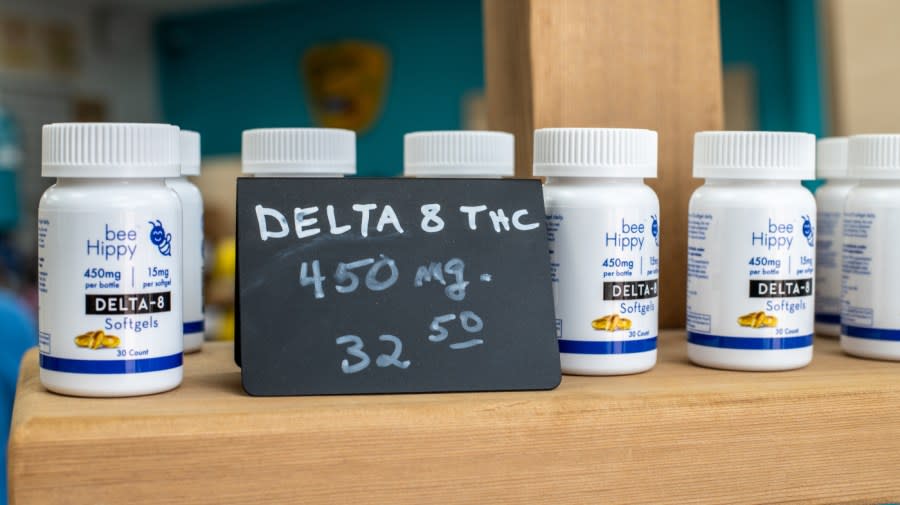What is delta-8? What to know about the alternative THC products and their use by teens

A recent study indicated 11 percent of 12th graders have used delta-8-tetrahydrocannabinol, or delta-8, the first time teen usage of the drug has been documented nationally.
The study, posted Tuesday in the journal JAMA and funded by the National Institutes of Health (NIH), found that among the high school seniors who reported using delta-8, which is legal for all ages in some areas, 90 percent said they have also used marijuana.
The NIH pointed out its “Monitoring the Future” study was given to students in classrooms, meaning it could represent an undercount as drug use can cause teenagers to miss school.
What is delta-8 THC?
Delta-8 comes from hemp, which is found in cannabis plants. Not much is known about its specific effects.
“Delta-8 is chemically synthesized, and what has been happening recently is that companies have been synthesizing delta-8 THC and putting it in a number of different types of consumable products like gummies and in vapes,” said Adam Leventhal, author of the study and executive director of the USC Institute for Addiction Science.
The NIH said delta-8 likely has similar effects to the primary THC component, delta-9, which makes people feel “high” from pot.
The study is the first time usage among teens has been widely documented, as delta-8 has only recently become popular.
“2023 was the first year that a question about this substance was included. We can’t really deduce whether prevalence is increasing, decreasing or staying the same, right? Because it’s only after you ask a question for the first time and then ask it for a few years can you determine whether there is like a broader trend over time,” said Sheila Vakharia, deputy director of research and academic engagement for Drug Policy Alliance.
Why is it popular?
Delta-8 has no federal minimum age requirement for purchase, making it very accessible, as it can be ordered online or in gas stations, the NIH said. The Food and Drug Administration put consumer warnings on the product in 2022.
“Eleven percent is a lot of people — that’s at least one or two students in every average-sized high school class who may be using delta-8. We don’t know enough about these drugs, but we see that they are already extremely accessible to teens,” said Nora Volkow, director of the National Institute on Drug Abuse.
The study found that popularity also corresponds with which region of the U.S. a student is in.
The South and Midwest had the most 12th graders using delta-8, at 14 percent and 15 percent, respectively. In the North, 10 percent were using the substance, compared to only 5 percent in the West.
Notably, 14 percent of 12th graders in states that have not legalized weed reported having used delta-8, compared to only 8 percent in states that have, with experts saying black markets could be having an effect on use.
How did it become legal for teens?
It is possible that delta-8 has so far slipped under the radar because hemp is used in other manufacturing products, and lawmakers have mostly focused on regulating delta-9.
“There was a federal legislation, which is referred to as the Farm Bill, that legalized manufacturing of hemp forms of the cannabis plant,” Leventhal said. “One of the reasons for that is hemp can be used in textiles, but part of the policy didn’t necessarily call out other types of intoxicating chemicals as being prohibited.”
The legislation prohibited products from containing more than 0.3 percent of delta-9, which was the most commonly known THC at the time.
Delta-8 “was something that was left open and, since 2018, the development and synthesis of delta-8 THC and other types of psychoactive chemicals from the hemp plant is something that is increasing,” Leventhal said
What does the future look like?
“The national trends documented by the Monitoring the Future survey provide critical information for research and policy to keep pace with new developments in the market for cannabis products, which has seen considerable change in recent years,” said Richard Miech, co-author of the NIH study.
Vakharia said it is important that further studies are done — both on delta-8’s rate of use, as well as really diving into its effects.
“We also need studies where people under controlled conditions are consuming those substances, and then we can monitor their effects as well, because that’s the kind of research that happens in a lot of these types of drug studies,” Vakharia said.
For the latest news, weather, sports, and streaming video, head to The Hill.

